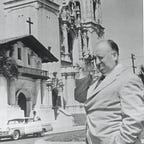Unit 9: A Liturgical Theology of Savoring
The concluding section of our course on Performing Beauty: Liturgy, Theology and Aesthetics focused on poetry. In this week’s reflection question, Dr. O’Malley asked, “What is poetry? What makes it hard to read? What does it reveal?” Even though I myself am one of those who find poetry difficult to read, I felt it appropriate to have the course conclude with poetry, only because it was a natural pause for some introspection of the last fifteen weeks.
In this unit, we focus on the word as means to the divine. As mentioned by Father Kahl Rahner, SJ, poetry and liturgy, are not the same but share a connection. The priest through his role in the liturgy serves as the poet who expresses the depth of the mystery he is celebrating. In liturgy we are remembering the promise that Christ gave us as Rahner states that “memory of our origin and our past among the essential components of our existence — but in such a way, that we go therein to meet the unique future that calls us, knowing that God’s future is our origin.”(Rahner, Poetry & the Christian, pg 6). For this week I will focus on the two poems, Love (3) by George Herbert and Easter Day by Christina Rosetti. These two poems will be used in catechesis in the RCIA process because both express the importance and power of the Eucharist and the meaning of Easter in our lives.
Love (3)
By George Herbert
Love bade me welcome: yet my soul drew back
Guilty of dust and sin.
But quick-eyed Love, observing me grow slack
From my first entrance in,
Drew nearer to me, sweetly questioning,
If I lacked anything.
A guest, I answered, worthy to be here:
Love said, You shall be he.
I the unkind, ungrateful? Ah my dear,
I cannot look on thee.
Love took my hand, and smiling did reply,
Who made the eyes but I?
Truth Lord, but I have marred them: let my shame
Go where it doth deserve.
And know you not, says Love, who bore the blame?
My dear, then I will serve.
You must sit down, says Love, and taste my meat:
So I did sit and eat.
FINIS
Glory be to God on high, and on earth
peace, good will towards men.
This poem by George Herbert is a beautiful display of a loving and merciful God. He did not abandon man, even after the fall. God loved us so that he sent his only son Jesus to earth. God is always welcoming us even though we are simple, broken, imperfect. God is always probing. Jesus is the ultimate sacrifice and sacrament, the tangible expression of God’s unwavering love and mercy. Because of that love, Jesus obediently atoned our sins, making salvation possible for everyone. This poem has a clear Eucharistic dimension. It reminds us that it does not matter who we are, or if we feel worthy enough to receive the Eucharist, Jesus’ sacrifice makes us worthy. It is vital in our faith journey to receive this sacrament. Many people do not feel worthy to receive the Eucharist unless going to confession. However, the poem displays a merciful God whose Eucharist forgives and nourishes. The Eucharist, as Sister Ann Astell commented, must be consumed because through Christ we are nourished. It is Christ’s flesh that gives us life to its fullest, and it’s Christ who is at the center of all that we do. When we participate in the Eucharist we restore the connection we have with Christ. This is incredibly important that no matter what we can always be restored back to Christ. We are always welcomed and loved.
EASTER DAY
by Christina Georgina Rossetti
Words cannot utter
Christ his returning:
Mankind, keep jubilee,
Strip off your mourning,
Crown with garlands,
Set your lamps burning.
Speech is left speechless;
Set you to singing,
Fling your hearts open wide,
Set your bells ringing:
Christ the Chief Reaper
Comes, His sheaf bringing.
Earth wakes her song-birds,
Puts on her flowers,
Leads out her lambkins,
Builds up her bowers:
This is man’s spousal day,
Christ’s day and ours.
This poem by Christina Rosetti is upbeat, full of jubilation and really gets to the core of what Easter means. Its focus is on healing, celebration, and resurrection. Her poem expresses great praise and even the environment is praising God. Out of the darkness, new life is possible, bringing our world back to order and harmony. Easter is extremely important in our catechetical work with RCIA. It is at the Easter Vigil where our catechumens are officially received into the church. It is the culmination of our study, but the first step in one’s faith journey. It’s vital to stress that in Easter we see God’s power in creation expressed and revealed in Jesus Christ on the Cross. It is through his crucifixion that he triumphed over evil. Life conquers death. In his resurrection and in our acceptance of our guide, the Holy Spirit, we are baptized into the church, becoming Christ’s bride. This poem exhibits celebration and connection to Christ as he is lighting our lamps, opening our hearts, and bringing us life to the fullest. I am reminded of Saint Francis of Assisi’s All Creatures of Our God and King when reading this poem because it has that same feeling and expresses a triumphant tone that we experience at Easter.
In conclusion, these two poems really express that above all else God is loving and merciful and this love is best expressed through his gift to us, Jesus Christ. That in and with Christ anything is possible. As mentioned by Dr. Rebekah Lamb, “Poetry seeks to recognize and express the value of existence, liturgy is the expression of the highest values, not just about the rational, incorporating mystery into our daily lives and finding a way to access it.”
